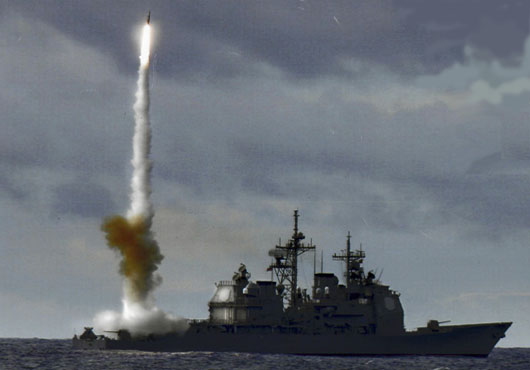Amb. Henry F. Cooper, Chairman Lt. Gen. Daniel Graham, Founder
High Frontier . . Building Truly Effective Defenses . . Reagan’s Vision Lives!
Flash Message 130426
Aegis and the Little Engine that Could!
By Ambassador Henry F. Cooper
April 26, 2013
Those who read little books as children rather that iPads, will recall steam engines (“cho, cho” engines) and the tale about the “Little Engine that Could” that went something like:
 What an appropriate model for those building the Aegis Ballistic Missile Defense (BMD) system!
What an appropriate model for those building the Aegis Ballistic Missile Defense (BMD) system!
I will admit to a special bias in favor of Aegis BMD, because it is living up to the vision I had for it as the third director of Ronald Reagan’s Strategic Defense Initiative (SDI). This vision became apparent to me in my 1990 review of the SDI program for then President George H.W. Bush and Defense Secretary Dick Cheney. They accepted my recommendations and asked me to lead a major redirection of the SDI program as the Berlin Wall came down and millions of Europeans gained their freedom.
That redirection emphasized a new threat to U.S. interests—not thousands of nuclear weapons on intercontinental ballistic missiles (ICBMs) launched from the former Soviet Union or its submarines, but a threat of up to couple hundred nuclear weapons that might be delivered on missiles of all ranges, launched from any number of places around the world to attack our interests and those of our allies and friends anywhere around the world. To respond to this new “post-Cold War” direction, we needed a global defense—and we called the new program Global Protection Against Limited Strikes (GPALS). It included for the first time a major role for defenses against shorter range ballistic missiles—labeled as Theater Missile Defense (TMD) systems—as well as a continued defense of the U.S. homeland, referred to as National Missile Defense (NMD) systems.
GPALS also had a very important space defense component, later ignorantly cancelled—but I’ll wait to discuss that story another time. Here, I want to discuss the other way we can affordably achieve a global defense—at sea, because there Aegis’ mobility can exploit well over half the earth’s surface that is covered with navigable waters.
We envisioned an important role for Aegis BMD from the start—initially emphasized as a TMD system, but with inherent growth capabilities to become an important NMD system as well. However, had we shown any interest in the latter capability, the program would most likely been canceled, because the Antiballistic Missile (ABM) Treaty banned any development or testing of a sea-based defense of the American homeland.
My advice to Admiral Frank Kelso, then Chief of Naval Operations, was never, never, never to mention that NMD potential—which was apparent at the time—in conducting the program that we initiated with the Navy to develop Aegis BMD as a TMD system.
The legacy of that discipline is no longer helpful, because many still do not appreciate Aegis’ potential in defending the U.S. homeland. Retired Vice Admiral J.D. Williams and I wrote about that potential in 2000 in hopes that President George W. Bush would not only withdraw from the ABM Treaty, but also invest in fully developing Aegis. Thankfully, President Bush did withdraw from the ABM Treaty, but did not take advantage of the new freedom to make Aegis “all it can be.”
If we had, it now would be easy for Aegis BMD to shoot down a North Korean space launch carrying a nuclear weapon while it is still rising from its launch pad, headed south over the South Pole to be detonated over the United States to produce an electromagnetic pulse that could lead to the death of a couple hundred million Americans during the next year. But I digress . . . let me get back to a bit more history before discussing what might be done with what we actually have today.
Aegis has continued to move ahead at a deliberate pace, with much help from its friends outside of the Pentagon. From the outset in the early 1990s, Aegis BMD has enjoyed bipartisan support on Capitol Hill—without which it would have been killed several times by the Pentagon in both Democrat and Republican administrations. Our Japanese partners in building the Aegis BMD system now deployed in the Far East rescued the program when the Pentagon “powers that be” were about to direct Aegis developers to build a new large interceptor rather than one that fits in the existing Vertical Launch System (VLS) deployed throughout the fleet—and that would have resulted in an extended, expensive development program which I doubt would have ever been deployed.
And its development continues to be stifled by those who think important tasks are a bridge too far for Aegis BMD, either as it is or as it can become. Yet, it perseveres like the “Little Engine that Could” with the best record of all missile defense systems today (25 intercepts out of 31 attempts)—and all its intercept attempts, from the beginning, have been conducted by operational crews—no other missile defense system can make that claim. Hence, it is a working operational system at sea around the world—at my last count 16 in the Pacific and soon to be a like number in the Atlantic.
The Aegis “can do” spirit was demonstrated in early 2008, when President Bush was looking for a way to shoot down a dying U.S. satellite that threatened to spread its toxic chemicals over populated areas. Aegis was selected over other options to conduct a mission for which it had never planned. Check here to see the YouTube video describing the February 20, 2008 event when the operational crew of the Lake Erie Aegis Cruiser shot down that satellite about 150 miles over the Pacific.
Now some say Aegis cannot shoot down a satellite launched from North Korea, to attack the U.S. from the south. I say, give the Navy “think I can” team a chance. As discussed in our April 17 message, there are three possible ways Aegis could be helpful in shooting down such a launch:
- Taking a shot at the North Korean rocket while it is still rising from its launch pad;
- Providing advance information to help cue the ground based interceptors in California so that they can be launched early to intercept the satellite in its first orbit before it reaches U.S. territory; and
- Shooting it down while it is in orbit.
There are challenges in all three possibilities. The second is probably easiest. The first requires achieving strenuous timing and sensor capabilities. The last because, at some altitude, the North Korean satellite will be too high to reach unless Aegis’ Standard Missile is given a higher velocity—would that “the powers that be” had provided this a decade ago when Admiral Williams and I were pressing them to do so.
In any case, I urge that the Aegis Team again be given its head and sufficient resources to see what it can do to give the President options for dealing with a very threatening possibility that may already exist—since North Korea has nuclear weapons with EMP capabilities we may not well understand and they have launched satellites in orbits that could threaten the U.S. from the south, as noted in earlier emails.
Alternatively, Deputy Defense Secretary Ashton Carter, who recently received the Missile Defense Agency’s Ronald Reagan Award, should probably dust off the 2006 Washington Post OpEd that he and Former Defense Secretary Bill Perry wrote on destroying the North Korean missile on the ground, entitled “If Necessary Strike And Destroy.” Notably, the New York Times recently published an OpEd by Jeremi Suri (“Bomb North Korea Before It’s Too Late”) echoing the Carter-Perry article’ conclusions.
There are disputes about whether North Korean ballistic missiles launched in a normal ballistic trajectory have sufficient range capability to reach the U.S. mainland, but there can be no dispute about whether a nuclear weapon on a satellite in a polar orbit can be detonated on-orbit above the United States—or anywhere else on the surface of the earth.
Unless destroyed before launch or intercepted afterward, such a satellite would approach America from the south and its payload could be detonated above Omaha—blanketing the entire United States with an EMP, the consequences of which could be, within a year, the death of a couple hundred million Americans. We have referred to this as a “back door” attack scenario, whereas our missile defense of the U.S. homeland is primarily deployed against a “front door” attack over the North Pole.
It is critically/urgently important to assure that such a back door attack cannot be carried out by North Korea, or in the future, Iran.
Can do?
And what can you do?
We can use your help in spreading the word to grass roots and local authorities to press the powers that be to provide for the common defense as they are sworn to do. Will you do your part?
Begin by passing this message to your friends and suggest they visit our webpage, www.highfrontier.org for more information. Also, please encourage your sphere of influence to sign up for our weekly e-newsletter!
Please click here to read Past Weekly Updates!
Please click here to read past Flash Messages!
Please help High Frontier continue this important and timely work!
Be sure to follow us on our Social Sites!
If you found this letter via our Social Sites, and you would like to subscirbe, click below!





